
![]() > Korea's Position on Dokdo > Q&A on Dokdo
> Korea's Position on Dokdo > Q&A on Dokdo

 How do early Korean government publications describe Dokdo?
How do early Korean government publications describe Dokdo?
Numerous early Korean government publications mention Dokdo, which demonstrates that Korea has long recognized and governed Dokdo as Korean territory.
Some of the most notable records pertaining to Dokdo in early Korean government publications are listed below.
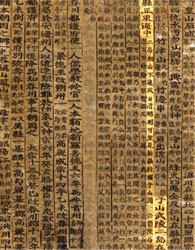
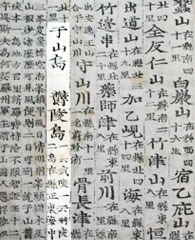
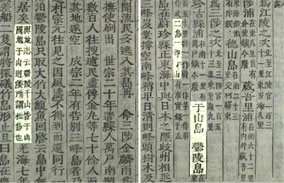
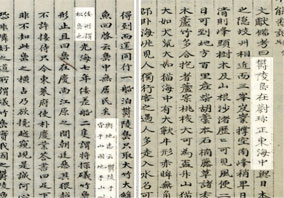
 What does the Inshū Shichō Gakki (Records on Observations in Oki Province), one of the earliest Japanese texts referring to Dokdo, say about the island?
What does the Inshū Shichō Gakki (Records on Observations in Oki Province), one of the earliest Japanese texts referring to Dokdo, say about the island?
Inshū Shichō Gakki (Records on Observations in Oki Province), 1667, is one of the earliest Japanese texts that mention Matsushima (the former Japanese name for Dokdo). It was written by Toyonobu Saitō, a local official of Izumo (eastern part of today’s Shimane prefecture), Japan. It describes Dokdo as follows:
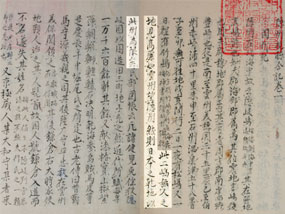
The description above shows that the Oki Islands marked Japan’s northwesternmost boundary and that Dokdo was not included within the scope of Japan’s territory.
 How is Dokdo portrayed in early Japanese maps?
How is Dokdo portrayed in early Japanese maps?
Dokdo does not appear in early maps commissioned by the Japanese government. For instance, Dokdo is missing from the Dainihon Enkai Yochi Zenzu (Maps of Japan’s Coastal Areas), 1821, a famous collection government-commissioned maps made from actual surveys by Tadataka Inō as per orders from the shogunate during the Edo period. Dokdo’s absence in these government-commissioned maps reflects the Japanese government’s recognition of Dokdo as non-Japanese territory.
The Kaisei Nihon Rotei Zenzu (Revised Complete Map of Japanese Lands and Roads), first published in 1779, has been presented by the government of Japan as an attempt to prove its territorial sovereignty over Dokdo. This map, produced by Sekisui Nagakubo, a Confucian scholar of the Edo period, instead, reveals that Ulleungdo and Dokdo are recognized by Japan as foreign territories.
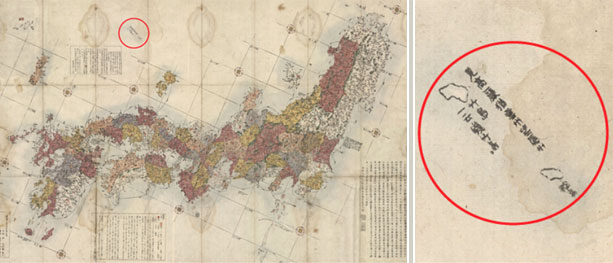
Furthermore, a quote from Inshū Shichō Gakki (Records on Observations in Oki Province) indicated on the map next to Dokdo (Matsushima) and Ulleungdo, reflects the understanding of Inshū Shichō Gakki that the Oki Islands form Japan’s northwesternmost boundary.
This is also clear from the fact that Ulleungdo (Takeshima) and Dokdo (Matsushima) are presented differently from Japanese territories in the map’s first edition as well as in the subsequent official editions: Ulleungdo and Dokdo, like mainland Joseon (Korea), are not colored and are positioned outside the longitudinal and latitudinal lines.
 What is the Tottori-han’s Submission, which revealed that Dokdo was not Japanese territory at the time of the Ulleungdo Dispute between Korea and Japan?
What is the Tottori-han’s Submission, which revealed that Dokdo was not Japanese territory at the time of the Ulleungdo Dispute between Korea and Japan?
A diplomatic row between Korea and Japan erupted in 1693 concerning the passage of Japanese fishermen to Ulleungdo (the Ulleungdo Dispute). On December 24, 1695, the Edo shogunate sent an inquiry to the Tottori-han (feudal clan of Tottori) asking whether Ulleungdo belonged to the Tottori-han, and whether there were other islands under the Tottori-han’s jurisdiction.
The next day, on December 25, the Tottori-han responded to the effect that Ulleungdo and Dokdo were not territories of Japan as follows: “As for Takeshima [Ulleungdo] and Matsushima [Dokdo], neither belongs to the two states [Inaba and Hoki: today’s Tottori prefecture] nor are there any other islands belonging to these two states.”
After thus confirming Ulleungdo and Dokdo’s jurisdictional status, the Edo shogunate cancelled the “passage license to Takeshima [Ulleungdo]” on January 28, 1696, prohibiting further passage to Ulleungdo.
 What is the significance of An Yong-bok’s activities with regard to Dokdo?
What is the significance of An Yong-bok’s activities with regard to Dokdo?
An Yong-bok, who lived during the reign of King Sukjong of the Joseon dynasty, made two trips to Japan, the first of which was against his own will in 1693 when he was captured by the Japanese in Ulleungdo. The 1693 kidnapping of An Yong-bok triggered the Ulleungdo Dispute between Korea and Japan. The kidnapping is significant because the jurisdictional status of Ulleungdo and Dokdo was confirmed in the course of the diplomatic negotiations that ensued.
Regarding An Yong-bok’s second trip to Japan in 1696, a record of An Yong-bok’s statement can be found in the Sukjong Sillok (Annals of King Sukjong’s Reign). It is recorded that An Yong-bok told the Japanese fishermen he encountered in Ulleungdo that “Matsushima is Jasando [Dokdo] which is Korean territory” and that he went over to Japan to lodge a protest against Japan’s encroachment on the Korean territories of Ulleungdo and Dokdo.
An Yong-bok’s journeys to Japan are recorded not only in Korean but also in Japanese documents, including Takeshima Kiji (Records of Takeshima), Takeshima Tokai Yurai Kinuki Gaki (Copy of Excerpts from Record of a Trip to Takeshima), Inpu Nenpyo (Chronology of Inaba Province), and Takeshimako (Notes on Takeshima).
Particularly noteworthy is a historical document discovered recently in 2005 in Japan entitled “Genroku Kyu Heishinen Chosenbune Chakugan Ikkan No Oboegaki” (Memorandum on the Arrival of a Boat from Joseon in 1696 – a report on An Yong-bok’s visit to the Oki Islands drafted by an official of the island). According to the report, An Yong-bok stated that Ulleungdo and Dokdo belonged to Gangwon-do, which corroborates the information in the Sukjong Sillok (Annals of King Sukjong’s Reign).
 What is the Repatriation Policy set forth by the government of Joseon (Korea)?
What is the Repatriation Policy set forth by the government of Joseon (Korea)?
The government of Joseon dispatched officials to Ulleungdo for the evacuation of the island’s residents to the mainland. This is known as the Repatriation Policy.
This was one of the island policies adopted by the government of Joseon considering the risks of pillage by Japanese pirates on Joseon’s islands, not an act of relinquishing Joseon’s sovereignty over Ulleungdo.
This is evidenced by the fact that the Joseon government continued to exercise sovereignty over Ulleungdo by dispatching officials to the islands. In the early Joseon period, special government agents (sunsimgyeongchagwan) were dispatched to Ulleungdo. During the reign of King Sukjong, the Joseon government implemented a government patrol and inspection system whereby officials were regularly dispatched to Ulleungdo and other such places. The dispatch of officials continued until the system was abolished in 1895.
 What is the Dajōkan Order of 1877, by which the Meiji government officially confirmed that Dokdo was not Japanese territory?
What is the Dajōkan Order of 1877, by which the Meiji government officially confirmed that Dokdo was not Japanese territory?
In the course of a land registry project during the Meiji period, the Ministry of Home Affairs sent “an Inquiry on Takeshima [Ulleungdo] and one other Island [Dokdo] in the East Sea as regards the Land Registry Project” to the Dajōkan (Grand Council of State), Japan’s highest decision-making body at the time. The Ministry of Home Affairs wanted to determine whether the said islands were to be included in the project.
The Dajōkan concluded that Ulleungdo and Dokdo did not belong to Japan following the diplomatic negotiations between the Edo shogunate and the Joseon (Korean) government (the Ulleungdo Dispute). Thereupon, the Dajōkan issued a directive to the Ministry of Home Affairs in March 1877. The directive states, “Regarding Takeshima [Ulleungdo] and one other island [Dokdo]…bear in mind that our country [Japan] has nothing to do with them.” This is the Dajōkan Order of 1877.
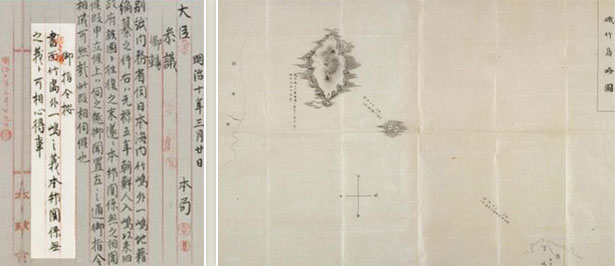
Along with its note of inquiry, the Ministry of Home Affairs sent Isotakeshima Ryakuzu (Simplified Map of Takeshima(Ulleungdo) – Japan used to refer to Ulleungdo as Isotakeshima) as a reference. Given that Takeshima (Ulleungdo) and Matsushima (Dokdo) appear on the map, it is evident that Dokdo is the “one other island” referred to in the phrase “Takeshima [Ulleungdo] and one other island” in the Dajōkan Order of 1877.
The Dajōkan Order of 1877 clearly demonstrates the Japanese government’s understanding that the status of Ulleungdo and Dokdo had been confirmed by the conclusion of the Ulleungdo Dispute between the Edo shogunate and the Joseon government in the 17th century.
It also mentions of “how Takeshima [Ulleungdo] and Matsushima [Dokdo] have come under Joseon’s jurisdiction” in “Chosenkoku Kōsai Shimatsu Naitansho” (Report on Past Interactions with Joseon). This report, drafted by Hakubo Sada and a team of officials based on their inspection of Joseon, was submitted to the Ministry of Foreign Affairs in 1870, seven years before the Dajōkan Order of 1877. It reveals the fact that the Ministry of Foreign Affairs at the time regarded the two islands as Joseon’s territory.
 What is the Imperial Decree No. 41 of 1900, by which the Emperor of Korea placed Dokdo under the jurisdiction of Ulleungdo?
What is the Imperial Decree No. 41 of 1900, by which the Emperor of Korea placed Dokdo under the jurisdiction of Ulleungdo?
In the late 19th century, various problems arose in Ulleungdo, including illegal logging by the Japanese. The government of the Korean Empire demanded that the Japanese government order the withdrawal of the illegal loggers. The Korean Empire also decided to strengthen laws pertaining to the local administration of Ulleungdo.
On October 24, 1900, the Uijeongbu (State Council) decided that “Ulleungdo shall be renamed Uldo” and “the post of inspector [dogam] shall be promoted to county magistrate [gunsu].” The changes were approved by the Emperor on October 25, 1900 and published as Imperial Decree No. 41 in the government’s official gazette on October 27, 1900.
Article 2 of Imperial Decree No. 41 stipulates that “as regards the districts, all of Ulleungdo as well as Jukdo and Seokdo [Dokdo] shall be placed under the jurisdiction of Uldo-gun (Uldo county),” explicitly including Dokdo among the districts under the jurisdiction of Uldo-gun (Uldo county).
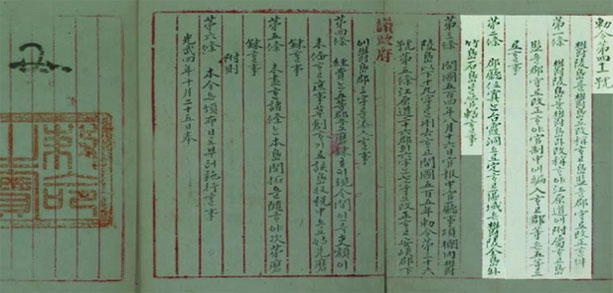
 고 島監을 郡守로 改正
고 島監을 郡守로 改正 件
件  야 江原道에 附屬
야 江原道에 附屬 고 島監을 郡守로 改正
고 島監을 郡守로 改正 야 官制中에 編入
야 官制中에 編入 고
고 事
事 台霞洞으로 定
台霞洞으로 定 고 區域은 鬱陵全島와 竹島 · 石島
고 區域은 鬱陵全島와 竹島 · 石島 管轄
管轄 事
事
As such, the Imperial Decree No. 41 clearly demonstrates the historical fact that the government of the Korean Empire exercised its sovereignty over Dokdo as a part of Ulleungdo.
 What was the backdrop against which Japan issued the Shimane Prefecture Public Notice No. 40 of 1905, and does this notice carry legal validity under international law?
What was the backdrop against which Japan issued the Shimane Prefecture Public Notice No. 40 of 1905, and does this notice carry legal validity under international law?
Japan had been at war with Russia over its interests in Manchuria and the Korean peninsula since 1904. Japan’s attempt at incorporating Dokdo into its own territory through the Shimane Prefecture Public Notice No. 40 in 1905 was aimed at meeting its military needs in the face of possible maritime clashes with Russia in the East Sea.
In a related Japanese historical document it is recorded that the territorial incorporation of Dokdo was being pursued based on the opinion of a Ministry of Foreign Affairs official that “building a watchtower and installing radio transmissions or submarine telegraph communication systems on Takeshima [Dokdo] would give us an advantage in terms of monitoring enemy ships.” Yozaburo Nakai, who petitioned for the territorial incorporation of Dokdo, had initially perceived Dokdo as Korean territory. Also, an official of Japan’s Ministry of Home Affairs stated, “… the disadvantages of arousing the suspicion that Japan harbors the ambition to annex Korea outweigh the advantages … by seizing the barren rocks [Dokdo] where not a blade of grass grows and which are considered to belong to Korea…” This points to the Japanese government’s recognition of Dokdo as Korean territory.
In February 1904, Japan compelled the Korean Empire to sign the Korea-Japan Protocol to ensure unlimited access to Korean territory in the execution of the Russo-Japanese War. Japan also coerced the Korean government to appoint Japanese and other non-Korean nationals as advisors through the First Korea-Japan Agreement in August 1904. In effect, Japan was systematically implementing its plan to take over Korea, and Dokdo was the first Korean territory to fall victim to Japanese aggression against Korea.
As is thus shown, the Shimane Prefecture Public Notice No. 40 was part of Japan’s systematic plan to undermine Korea’s territorial integrity. Japan’s attempt to incorporate Dokdo into its own territory was an illegal act that infringed upon Korea’s undeniable sovereignty over the island, which had been established over a long period of time. Accordingly, the Shimane Prefecture Public Notice No. 40 is null and void under international law.
 What did Sim Heung-taek, the county magistrate of Uldo-gun (Ulleungdo), report to the acting governor of Gangwon-do regarding Dokdo in 1906?
What did Sim Heung-taek, the county magistrate of Uldo-gun (Ulleungdo), report to the acting governor of Gangwon-do regarding Dokdo in 1906?
A Japanese survey team comprised of officials and civilians from the Shimane Prefecture visited Ulleungdo and informed Sim Heung-taek, the county magistrate of Uldo-gun(Uldo county) that Dokdo had been incorporated into Japanese territory.
On April 29, 1906, Yi Myeong-rae, the county magistrate of Chuncheon-gun(Chuncheon County) and the acting governor of Gangwon-do(Gangwon province) reported the matter to the Uijeongbu(State Council of the Korean Empire).
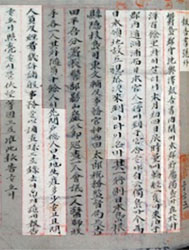
 야 自云 獨島가 今爲日本領地 故로 視察次 來到이다 이온바... 先問戶總 ∙ 人口 ∙ 土地 ∙ 生産 多少
야 自云 獨島가 今爲日本領地 故로 視察次 來到이다 이온바... 先問戶總 ∙ 人口 ∙ 土地 ∙ 生産 多少 고 且問 人員 及經費 幾許 諸般事務을 以調査樣으로 錄去이
고 且問 人員 及經費 幾許 諸般事務을 以調査樣으로 錄去이 기 玆에 報告
기 玆에 報告 오니 照亮
오니 照亮 시믈 伏望等 因으로 准此 報告
시믈 伏望等 因으로 准此 報告 오니 照亮
오니 照亮 시믈 伏望
시믈 伏望
Thereupon, on May 10 of the same year, the Uijeongbu, the highest decision-making body of the Korean Empire, issued the following directive (Directive No. 3)

 閱悉이고 獨島領地之說은 全屬無根
閱悉이고 獨島領地之說은 全屬無根 니 該島 形便과 日人 如何 行動을 更爲査報
니 該島 形便과 日人 如何 行動을 更爲査報 事
事
This shows that the county magistrate of Uldo-gun (Ulleungdo) continued to govern Dokdo in 1906 pursuant to Imperial Decree No. 41 issued in 1900.
 What are the terms of the Cairo Declaration of 1943, which laid out the basic position of the Allied Powers on Japan’s territorial boundaries after World War II?
What are the terms of the Cairo Declaration of 1943, which laid out the basic position of the Allied Powers on Japan’s territorial boundaries after World War II?
In the Cairo Declaration (December 1, 1943), which laid out the basic position of the Allied Powers on Japan’s territorial boundaries after the end of World War II, it is stated that “Japan will also be expelled from all other territories which she has taken by violence and greed.”
The Cairo Declaration also confirms the independence of Korea as follows: “three great powers, mindful of the enslavement of the people of Korea, are determined that in due course Korea shall become free and independent.”
The Potsdam Declaration of 1945, which Japan accepted as a condition of its surrender, reconfirms that “the terms of the Cairo Declaration shall be carried out.”
 What was the position of the Supreme Commander of the Allied Powers as regards Dokdo when World War II came to an end in 1945?
What was the position of the Supreme Commander of the Allied Powers as regards Dokdo when World War II came to an end in 1945?
After the end of World War II, the General Headquarters of the Supreme Commander for the Allied Powers excluded Dokdo from those territories controlled and administered by Japan as mandated in its instruction in SCAPIN (Supreme Commander for the Allied Powers Index Number) 677 on January 29, 1946.
Paragraph 3 of the said instruction lists “the four main islands of Japan (Hokkaido, Honshu, Kyushu and Shikoku) and the approximately 1,000 smaller adjacent islands” as the territories of Japan and excludes “Utsuryo (Ullung) Island, Liancourt Rocks [Dokdo] and Quelpart (Saishu or Cheju) Island.”
Moreover, SCAPIN 1033 prohibited Japanese vessels or personnel from coming within 12 nautical miles of Dokdo.
 What are the provisions of the 1951 Treaty of Peace with Japan regarding Dokdo?
What are the provisions of the 1951 Treaty of Peace with Japan regarding Dokdo?
Article 2(a) of the Treaty of Peace with Japan of 1951 provides “Japan recognizing the independence of Korea, renounces all right, title and claim to Korea, including the islands of Quelpart, Port Hamilton and Dagelet.”
Of Korea’s some 3000 islands, the said article lists only Jejudo (Quelpart), Geomundo (Port Hamilton), and Ulleungdo (Dagelet) as examples. Therefore, the mere fact that Dokdo is not explicitly mentioned in the said article does not suggest that Dokdo is not included among those territories of Korea separated from Japan.
In consideration of the Allied Powers’ stance reflected in the Cairo Declaration of 1943 and SCAPIN 677 of 1946, it should be understood that Dokdo is included among the territories of Korea separated from Japan.
 What was the Korean government's response to its Japanese counterpart's proposal in 1954 to refer the issue of Dokdo to the International Court of Justice (ICJ)?
What was the Korean government's response to its Japanese counterpart's proposal in 1954 to refer the issue of Dokdo to the International Court of Justice (ICJ)?
In 1954, when the government of Japan demanded that the matter of Dokdo be taken to the International Court of Justice (ICJ), the government of the Republic of Korea conveyed its views to the Japanese party as follows:
The government of the Republic of Korea continues to maintain the same position.
 How is the Republic of Korea exercising its sovereignty over Dokdo?
How is the Republic of Korea exercising its sovereignty over Dokdo?
The Republic of Korea holds legislative, administrative and judicial jurisdiction over Dokdo.

The government of the Republic of Korea will continue to protect the territorial integrity of Dokdo
